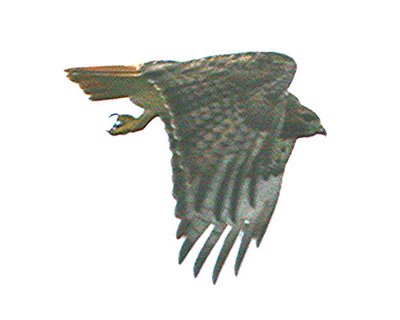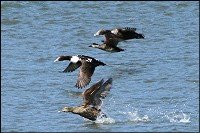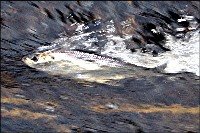Wednesday, November 29, 2006
Monday, November 27, 2006
British Soldiers and Pink Earth
British Soldiers, Pink Earth, Pixie Cups; all rather fanciful and whimisical names that I find fascinating. As equally fascinating are the small, diminutive lichens that these nomenclature represent. Looking down, rather than up to the sky or high in the treetops, had some pretty spectacular surprises in store for me yesterday. In fact more that just looking down, a hands and knees view can be very rewarding.
British Soldiers: These hands ome, red clad lichens reminded early Americans of the uniforms of British soldiers during times of their presense in North American ; and thus their name.
ome, red clad lichens reminded early Americans of the uniforms of British soldiers during times of their presense in North American ; and thus their name.
The source of the name of the pastel pink lichen to the left, Pink Earth, appeared to be visually self explanatory when viewed spread over the earth  below my feet. Pixie Cups; now that is a naming word of enchant -ment and I am taken back to the imaginary realms of childhood when I look at these very, tiny cup like lichens. Why not get down close to the earth and look for them too.
below my feet. Pixie Cups; now that is a naming word of enchant -ment and I am taken back to the imaginary realms of childhood when I look at these very, tiny cup like lichens. Why not get down close to the earth and look for them too.
Posted by
me ann my camera
at
11:13 AM
0
comments
![]()
Sunday, November 26, 2006
Common Goldeneye

I enjoyed many sightings of Common Goldeneye along the St. John River yesterday but they were rather skittish whenever I stopped along the highway to view them from my car. That's the reason why most all of my photos included in this post are of departing Goldeneye in flight or take off.
That's the reason why most all of my photos included in this post are of departing Goldeneye in flight or take off.  I had to catch these beautiful birds 'on the wing' as they quickly dispersed.
I had to catch these beautiful birds 'on the wing' as they quickly dispersed.
Although the round white circle on the auriculars of the male Common Goldeneye is an easily identifiable marking (not to be confused with the white crescent of the less common Barrows Goldeneye); it is the 'golden eye' of this duck from which it derives its name. In the composite photo below, (of photos taken in 2004), the golden eye of both the male and female Common Goldeneye is easily seen.
Posted by
me ann my camera
at
10:12 AM
0
comments
![]()
Friday, November 24, 2006
Thursday, November 23, 2006
male Purple Finch
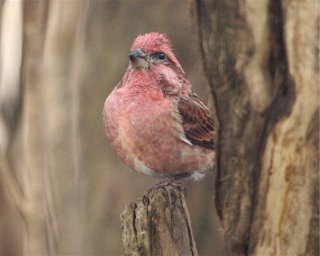 We have seen very few Purple Finch this fall but for a couple of days this week have had one male and two females show up at our feeders for very brief periods of time.
We have seen very few Purple Finch this fall but for a couple of days this week have had one male and two females show up at our feeders for very brief periods of time.
Posted by
me ann my camera
at
7:54 AM
0
comments
![]()
Sunday, November 19, 2006
Wildflower Identification

 Perhaps you might think this an in- appropriate seasonal topic but having spent much time yesterday pondering over the id of a wildflower that I found still in bloom, (photographed Nov. 17), I thought the topic worthy of mention. Sticky Groundsel had had me mystified since having first taken pictures of it in early September and I was unable to id it at the time so I had filed the photos under 'unknown wildflower'.
Perhaps you might think this an in- appropriate seasonal topic but having spent much time yesterday pondering over the id of a wildflower that I found still in bloom, (photographed Nov. 17), I thought the topic worthy of mention. Sticky Groundsel had had me mystified since having first taken pictures of it in early September and I was unable to id it at the time so I had filed the photos under 'unknown wildflower'.
When looking for the id of an unknown wildflower I always check in Peterson's Wildflowers field guide first. While searching through the field guide in September I had noticed leaves similiar to those in my photos but the illustrations for Stinking Groundsel (Peterson's Wildflowers p.167) did not show any open blossoms with yellow petals as in my photos; so I passed it by.
Yesterday I decided to pursue 'Groundsel' further and found mention of the plant in Hal Hinds book, Flora of New Brunswick, p.473; and here was another clue for me . Sticky or Stinking Groundsel was found in waste areas and along railways; and that's exactly where I had  found it; along the railroad tracks! Of the three Groundsels mentioned by Hinds, Sticky Groundsel was the only one that made mention of 'railways'; so maybe I was on the right track afterall. However, Hinds' book did not include any illustrations showing open petals blossoms either so I then turned to Google and did an image search for Sticky Groundsel. Doing an image search was very productive and I found several sites showing images which included the yellow petaled bloom stage as in my photos. Mystery solved!
found it; along the railroad tracks! Of the three Groundsels mentioned by Hinds, Sticky Groundsel was the only one that made mention of 'railways'; so maybe I was on the right track afterall. However, Hinds' book did not include any illustrations showing open petals blossoms either so I then turned to Google and did an image search for Sticky Groundsel. Doing an image search was very productive and I found several sites showing images which included the yellow petaled bloom stage as in my photos. Mystery solved!
reference sources:
Hinds, Harold, Flora of New Brunswick, Biology Department, UNB 2000
Peterson, Roger Tory, A Field Guide to Wildflowers Northeastern and North-central North America, Houghton Mifflin Co. 1996
Posted by
me ann my camera
at
8:09 AM
0
comments
![]()
Friday, November 17, 2006
American Widgeon
 When I first started birding I could identify very few duck species just by sight. Even though I might sight several different species all at the same time, most of them
When I first started birding I could identify very few duck species just by sight. Even though I might sight several different species all at the same time, most of them  would have flown away before I could find their id in my bird guide book. It took more than one season for me to gain the ability to scan a group and be able to list the different species at a glance. However, when I spied some American Widgeon last weekend among a group of Mallards and Black Ducks no field guide book was necessary to id them. The warm brownish
would have flown away before I could find their id in my bird guide book. It took more than one season for me to gain the ability to scan a group and be able to list the different species at a glance. However, when I spied some American Widgeon last weekend among a group of Mallards and Black Ducks no field guide book was necessary to id them. The warm brownish  colouring of the body and the white crown and flanks of the male Widegon are easily noted identifiable visual characteristics of this bird. Also the shading around the eyes of these ducks makes me think they are wearing 'eye shadow.'
colouring of the body and the white crown and flanks of the male Widegon are easily noted identifiable visual characteristics of this bird. Also the shading around the eyes of these ducks makes me think they are wearing 'eye shadow.'
Posted by
me ann my camera
at
7:49 PM
0
comments
![]()
Thursday, November 16, 2006
Wednesday, November 15, 2006
American Black Duck x Mallard Hybrid


(photo above of a male Mallard and a female American Black Duck)
While observing a large group of Mallard Ducks yesterday I also noticed a few American Black Ducks among them. I then saw one duck which had a few charactistic features of both species. This was an American Black Duck x Mallard hybrid; (see photos above right and below)the result of an Amercian Black Duck and a Mallard breeding.
reference source: The Sibley Guide to Birds; by David Allen Sibley, p-83 
Posted by
me ann my camera
at
9:35 AM
0
comments
![]()
Tuesday, November 14, 2006
Cattle Egret


This Cattle Egret photo (above) was taken this weekend past in Saint John, NB on November 12th. The only other time I had seen a Cattle Egret in New Brunswick was on October 21, 2001 at Sheffield. At that time I was quite distant from the bird and didn't have the opportunity to get many details of the egret up close. However, it was fun to capture both the Cattle Egret and Cattle in the same shot.
Posted by
me ann my camera
at
6:46 PM
0
comments
![]()
Saturday, November 11, 2006
Chipping Sparrow Still Here
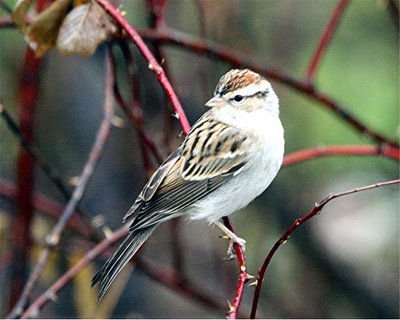
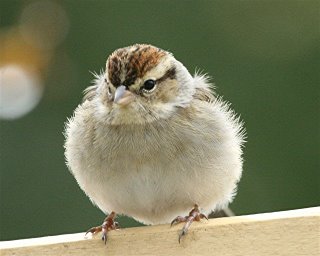 They arrive every April, during the latter part of the month and stay around our feeder area until late October or early November.
They arrive every April, during the latter part of the month and stay around our feeder area until late October or early November.
I have no sighting records of them here in Nov. 2005 however
- in 2003 my last sighting of them was on Nov. 4th
- in 2002 on the 3rd
- in 2001 they were gone by November
- in 2000 they left on the 3rd.
In 2006, as of yesterday, November 10th, one is still here! This is the latest in the fall season that I have seen these little Chipping Sparrows at our feeders.
Posted by
me ann my camera
at
7:51 AM
0
comments
![]()
Tuesday, November 07, 2006
female Red-winged Blackbirds

Our first snow came yesterday and with it came a small flock of Red-winged Black birds , stopping for a while to feed before continuing their flight to more southern regions. Female Red-winged Blackbirds had been a mystery to me when I first noticed them at our feeders a few years ago; at first I did not know what they were for they looked so different from their male counterparts. Yesterday both male and female Red-winged Blackbirds were at our feeder area.
to view a posting on male Red-winged Blackbirds go to:http://naturetales.blogspot.com/2007/03/male-red-winged-blackbird.html
Posted by
me ann my camera
at
8:21 AM
0
comments
![]()
Monday, November 06, 2006
American Tree Sparrows
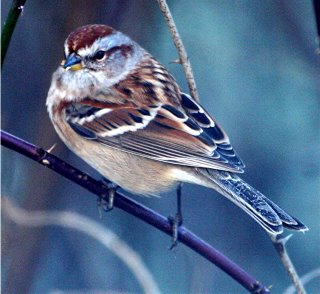 These little northern sparrows, American Tree Sparrows, arrived at our feeders last week. Tree Sparrows breed from Alaska to northern Labrador and then migrate to more southern areas to winter. I wait for them to return
These little northern sparrows, American Tree Sparrows, arrived at our feeders last week. Tree Sparrows breed from Alaska to northern Labrador and then migrate to more southern areas to winter. I wait for them to return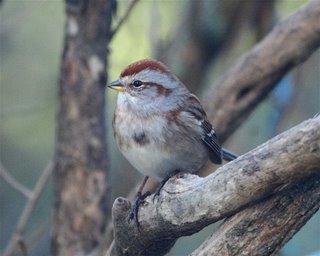 every year around this time and they have become a seasonal marker for me; bringing with them the expectation that snow and cold weather, which heralds the beginnings of winter, will soon follow.
every year around this time and they have become a seasonal marker for me; bringing with them the expectation that snow and cold weather, which heralds the beginnings of winter, will soon follow.  The little dark spot in the center of their breasts easily separates them from other sparrows. Another identifying feature is their yellow lower mandible, the lower part of their bills.
The little dark spot in the center of their breasts easily separates them from other sparrows. Another identifying feature is their yellow lower mandible, the lower part of their bills.
Posted by
me ann my camera
at
8:00 AM
0
comments
![]()
Sunday, November 05, 2006
Red Crossbills

 At first when I saw this small flock of birds in the sunlight, gathered on the dirt road ahead of us, I thought they were a group of Goldfinch.
At first when I saw this small flock of birds in the sunlight, gathered on the dirt road ahead of us, I thought they were a group of Goldfinch. 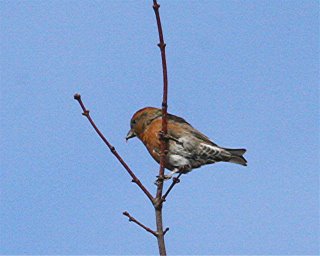 My first glance had seen the yellow and greyish colouring and I almost drove on but then I also caught a glimpse of red. A male Red Crossbill! And a closer look told me that the yellowish birds that I had thought were Goldfinch were actually juvenile and female Red Crossbills.
My first glance had seen the yellow and greyish colouring and I almost drove on but then I also caught a glimpse of red. A male Red Crossbill! And a closer look told me that the yellowish birds that I had thought were Goldfinch were actually juvenile and female Red Crossbills.  Crossbills get their name from the crossed positioning of their bills and this photo close up to the left of a juvenile Red Crossbill shows this feature quite well quite well. It isn't often that Crossbills visit feeders but Ihave included two pictures below of ones that did sometime around 2003. The first is of a male Red Crossbill and the last photo is of a White-winged Crossbill.
Crossbills get their name from the crossed positioning of their bills and this photo close up to the left of a juvenile Red Crossbill shows this feature quite well quite well. It isn't often that Crossbills visit feeders but Ihave included two pictures below of ones that did sometime around 2003. The first is of a male Red Crossbill and the last photo is of a White-winged Crossbill.
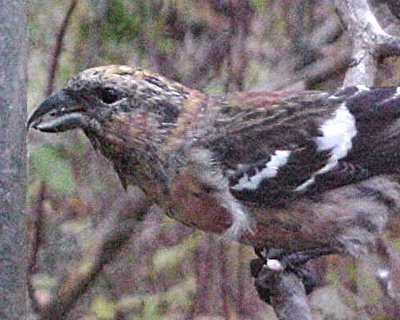
To view other postings on Red Crossbills please go to:
http://naturetales.blogspot.com/2007/03/adult-female-red-crossbill.html
http://naturetales.blogspot.com/2007/03/male-red-crossbill.html
Posted by
me ann my camera
at
9:03 AM
0
comments
![]()
Saturday, November 04, 2006
Cedar Waxwing

Another masked visitor; but this was a welcome one. This handsome Cedar Waxwing visited our feeder area this week and checked out the remaining supply of crabapples on our Flowering Crabapple tree.
Posted by
me ann my camera
at
8:39 AM
0
comments
![]()
Friday, November 03, 2006
juvenile Robin

 I've never seen a juvenile Robin this late into the autumn season but the few lingering spots on this birds rusty breast suggests to me that this is a young Robin.
I've never seen a juvenile Robin this late into the autumn season but the few lingering spots on this birds rusty breast suggests to me that this is a young Robin. It was perched in our Flowering Crabapple tree this morning; then it dropped to the ground below and fed briefly before it flew away.
It was perched in our Flowering Crabapple tree this morning; then it dropped to the ground below and fed briefly before it flew away.
Posted by
me ann my camera
at
7:11 PM
0
comments
![]()
Thursday, November 02, 2006
Nightly Visitors
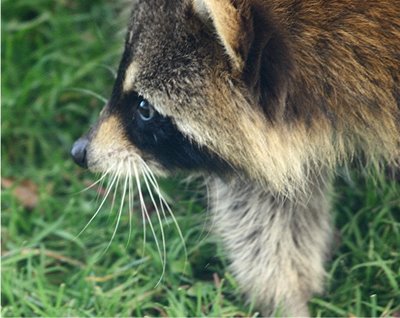
 On Hallowe'en night we treated over a hundred welcome visitors, however there are a couple of
On Hallowe'en night we treated over a hundred welcome visitors, however there are a couple of  persistent masked visitors that have worn out their welcome long ago! Usually night time visitors, last week I watched from my
persistent masked visitors that have worn out their welcome long ago! Usually night time visitors, last week I watched from my 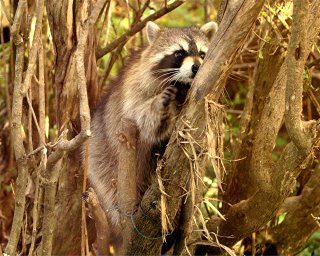 window as two Raccoons checked out our feeder area during the afternoon. However they did provide a good photo opportunity and I took a few pictures before we sent them on their way.
window as two Raccoons checked out our feeder area during the afternoon. However they did provide a good photo opportunity and I took a few pictures before we sent them on their way.
Posted by
me ann my camera
at
7:32 AM
0
comments
![]()




